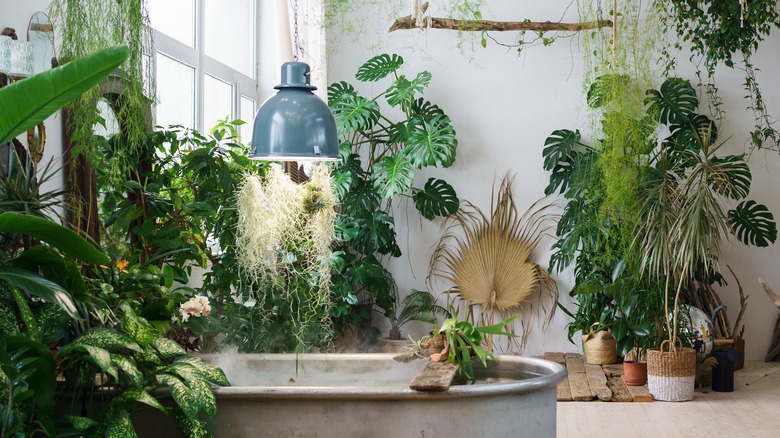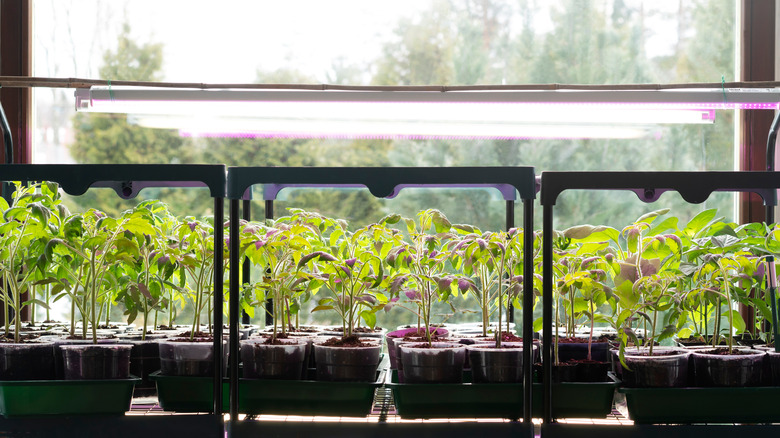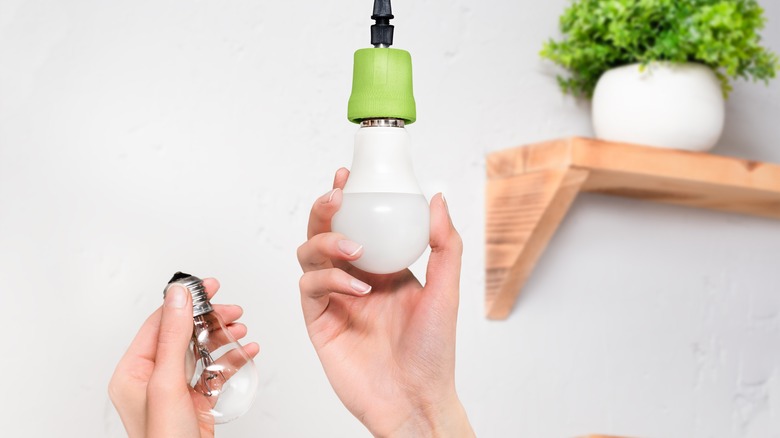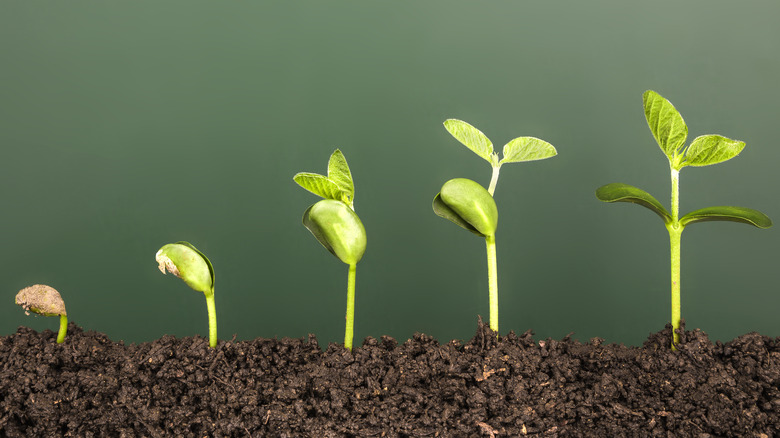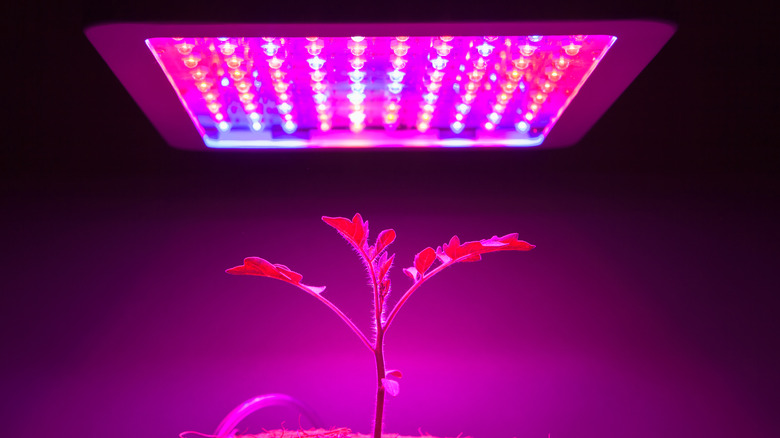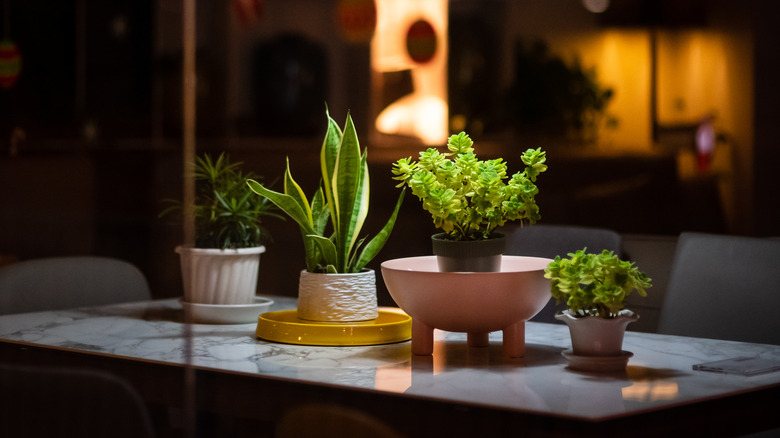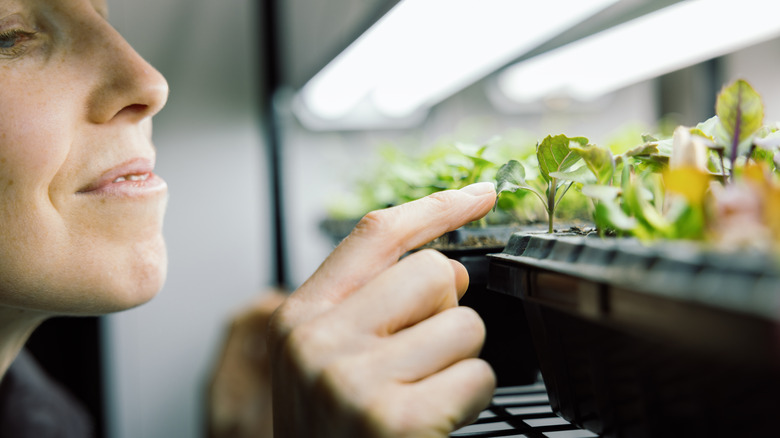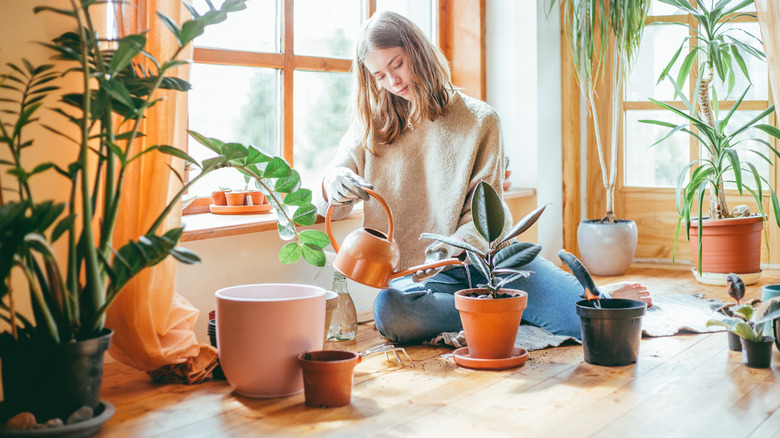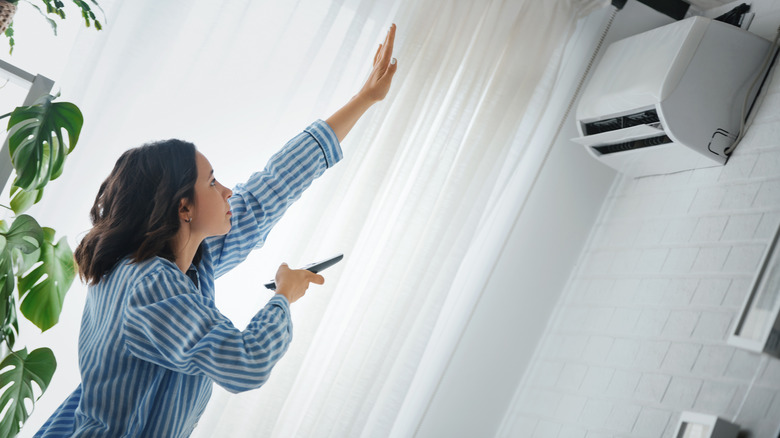Crucial Grow Light Mistakes That Can Secretly Kill Your Plants
Grow lights are one of the best tools to keep your plants thriving indoors, especially in low-light spaces. While standard household bulbs don't do much for plants, grow lights emit specific wavelengths that can mimic the full light spectrum of the sun. For homes that don't get a lot of sunlight coming in, supplementing it can help promote photosynthesis.
However, if you aren't using grow lights correctly, they could have the opposite of your desired effect. Unfortunately, it's not as simple as purchasing them and hanging them up. Each plant is unique and requires a different level of sunlight to grow, so it's important to plan carefully when creating your setup. It's also crucial that you keep an eye on your growing plants and light intensity, placement, and other factors. Although there is a lot to consider when it comes to grow lights, the process isn't as challenging as you may think. As long as you avoid the mistakes below, this artificial light source will surely keep your houseplants happy.
Ensure the lights are at a proper distance
One of the most important factors to consider when installing grow lights is placement. Hanging them too far above the foliage may cause insufficient lighting or encourage your plants to reach too high, possibly weakening them. Placing them too low could cause burning and other damaging effects. Because not all grow lights are created equal, the best height for your lights will vary based on quality. When you select your lights, the manufacturer will typically have instructions for proper placements. Generally speaking, most recommend hanging them 12 to 36 inches above the canopy.
Fortunately, it'll be easy to determine if you need to adjust the distancing. If your plant's leaves start yellowing, look dry, or get brown spots, it may be a sign the light is too close. On the other hand, if the light is too far away, you'll notice less variegation, leggy vines, slower growth, or smaller leaves.
Choosing low-quality grow lights
While it may be tempting to buy a less expensive grow light, it's likely worth it to invest in a high-quality option. And, rather than selecting them solely based on cost, you'll want to pay attention to two specs: Correlated Color Temperature (CCT) and Color Rendering Index (CRI). The CCT refers to the light source's color spectrum. CRI ratings measure how the artificial white light compares with natural sunlight. For the CCT, aim for a rating of at least 4,000K (Kelvin). However, closer to 6500K is ideal. You'll also want to choose a grow light with a CRI rating of at least 85, with 100 being the best.
The benefits of choosing high-quality LED lights don't stop with being better for your plants; they also tend to be more energy-efficient. In fact, they can use up to 90% less energy than other light sources, like incandescent lighting. They also last 25% longer, so you'll get more use out of them.
Not adjusting the light with growth
As your plant grows, it's crucial to adjust your grow lights with it. This is especially important if you're starting them as seedlings or caring for fast-growing houseplant varieties. Placement depends on the strength of the LED light, though many brands offer adjustable intensity. If you're dealing with a plant type that grows upward quickly, choose a grow light that's easily adjustable to keep it a consistent distance away.
If you're starting your plant as a seedling, place your LED grow lights about 6 to 12 inches above the canopy. Ideally, adjust the intensity to about 30% or aim closer to 12 inches away for high-powered lights. Once your plant reaches the vegetative stage, raise the lights to about 18 to 24 inches away from the top leaves. You can increase the intensity to about 50% at this time. When your plants reach the flowering stage, you can increase the intensity to full or near full intensity and adjust the height to hover 18 to 24 inches above the blooms.
Using the wrong light spectrum
High-quality grow lights will have different spectrum settings to choose from. You can also purchase specific light spectrums, depending on the plants you own. No matter your chosen lamp, you want to use LEDs that best serve your plants, including blue light, red light, or a combination of both. Blue lights encourage photosynthesis and chlorophyll absorption to aid plant growth. Red light wavebands are also essential for growth, though they promote budding and flowering as well. Some brands offer green light, though it isn't as vital as red or blue lighting. However, it can also help encourage photosynthesis.
Because seedlings are in a growth stage, they get the most energy from blue light, so using a ratio of more blue than red is best. During the vegetative stage, a combination of the two colors is optimal to assist leaf, stem, and overall growth. Then, once the plant reaches the flowering stage, leaning more toward red light can promote budding.
Not following the correct light schedule for your plants
Whether you use the timer function on your grow lights or manually turn them on and off, it's vital to do so with a schedule in mind. On average, houseplants require 8 to 16 hours of light each day, though you may need more or fewer hours depending on the plant's stage. The seedling stage requires the most light for healthy growth, so aim for 14 to 16 hours. Once your plant is in the vegetative stage, you can gradually decrease the time your plant receives. Then, to stimulate flower production during the flowering stage, aim for approximately 12 hours of light daily.
Although plants need plenty of light to thrive, you don't want to turn your grow lights on at night or leave them on all day. You'll want to ensure your plants get at least six hours of rest time without lights to go through their respiration process. Seedlings need to "sleep" for about six hours in darkness, while established plants need about 8 to 10 hours of nighttime conditions.
Not keeping up with maintenance
Although grow lights are easy enough to install, you don't want to forget about them once they're up and running. One thing many fail to do is use a power stabilizer, which can extend the life of your grow lights. Worse, not using one can cause malfunctions in your grow light. Power stabilizers maintain adequate wattage and voltage, which provides the proper amount of heat for your plants.
You should never place your grow lights in a room with excess moisture, as the water can seep in and damage them. To ensure there aren't any issues, carefully assess the condition of your bulbs and their power units from time to time. If there are any deficiencies like rust, discoloration, or other noticeable issues, it may be time to switch them out. You should also clean out any dust and dirt build-up you see during your inspection.
Overfeeding or overwatering your plants
If you've been in the habit of watering your plants on a certain schedule, keep in mind that grow lights may affect that frequency. Some grow lights will dry the soil quicker, requiring you to water your plants more often. However, if you switch to an LED grow light from another type like HIDs, and continue this watering schedule, you run the risk of overwatering your plants. LED lights provide a lot of energy for your plants but are cooler so they don't dry up the soil as quickly.
The best way to combat this issue is to check your plant's soil weekly, either using your fingers or a plant water gauge. For most types, you can check the top inch of the soil and only water when it feels dry or when the gauge shows low moisture levels. Water carefully to avoid getting your light wet and causing damage.
Neglecting other plant growth factors
Light is one of the most essential elements for plant growth, but it's not the only one. Just because you've provided your plant with a grow light doesn't mean you don't have to optimize the other conditions. You'll want to ensure you're providing suitable soil, water, humidity, and temperature for your specific houseplants.
One significant factor many forget about is maintaining the proper temperature. Temperature influences nearly every process, like photosynthesis. When the temperature rises, so do the plant's growth processes. In winter, do your best to maintain adequate temperatures. However, you can expect your houseplants to grow more slowly in the cooler months.
Aside from watering and feeding, you will want to consider the specific needs of each variety. Some houseplants prefer dry environments, while some need humidity. Similarly, every type requires a different soil pH, with most ranging from 6.0 to 7.0. For example, tropical plants require well-draining and acidic soil and plenty of moisture. So, ensure all of the right conditions can work in tandem with your grow light to fully support your plants.
